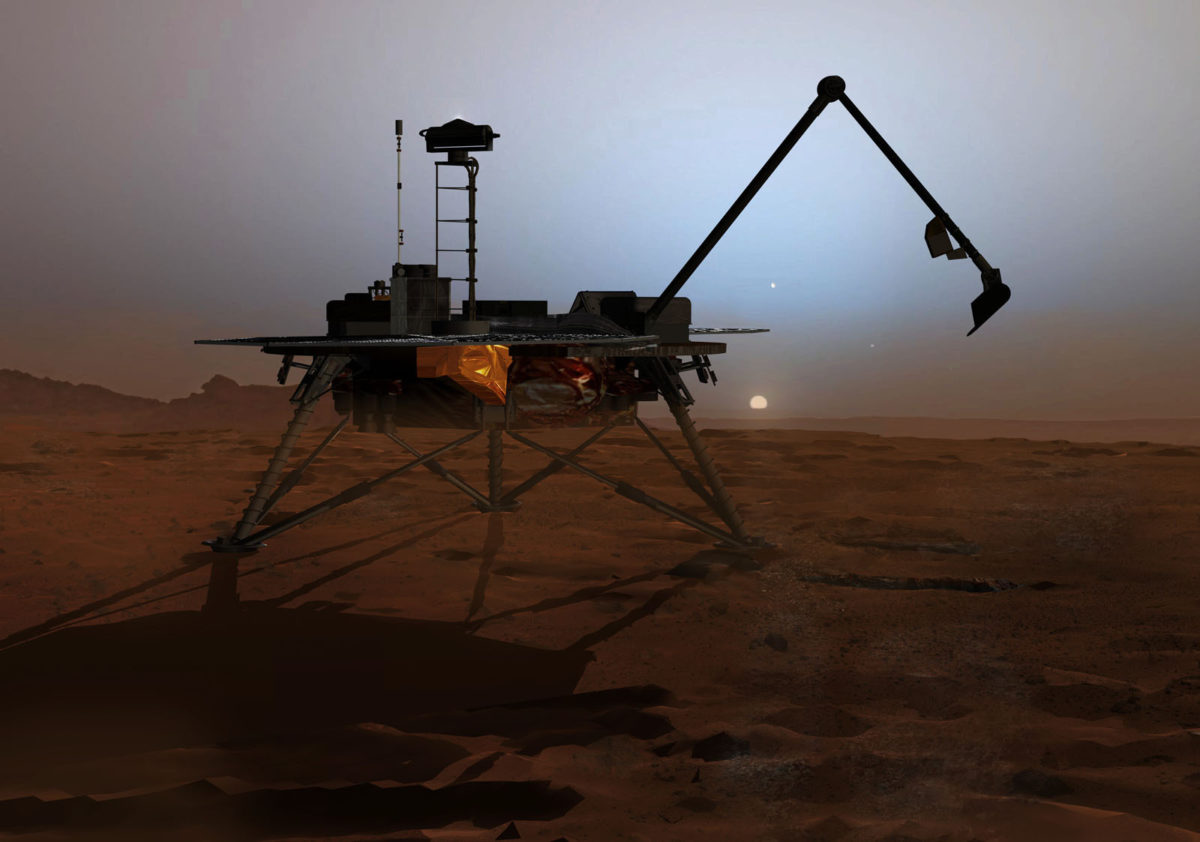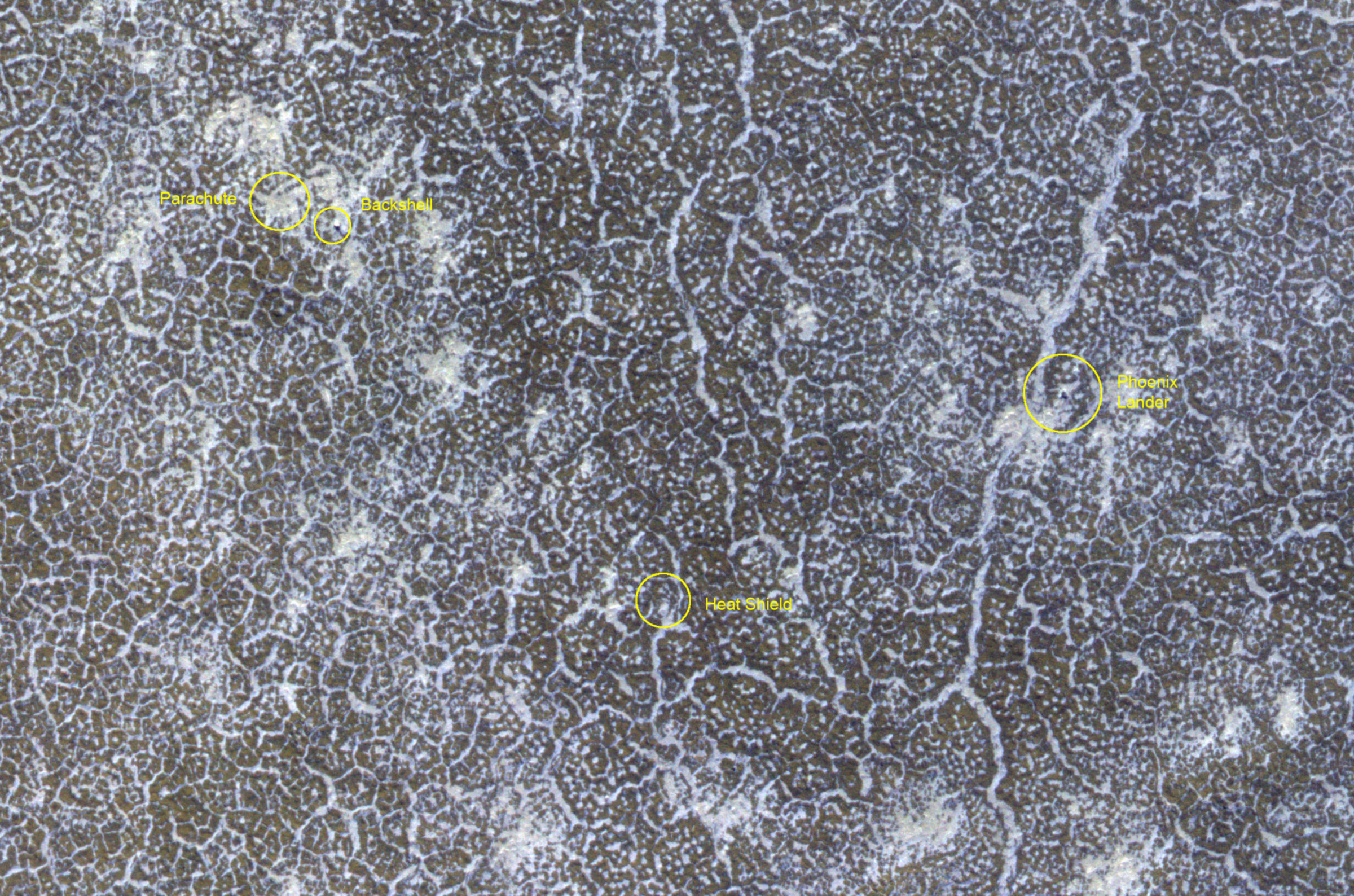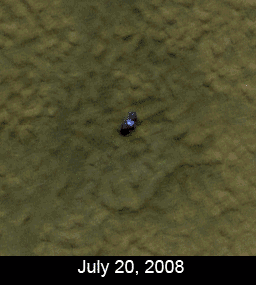Emily Lakdawalla • Jan 11, 2010
Odyssey's going to start listening for Phoenix
It's been the second most popular question I get from readers: "When might we possibly hear from Phoenix?" (The most popular question is "Can't they use the arm to free Spirit?" And the answer to that one is no.) I've always answered "they'll start listening for Phoenix some time in January," but today there was a press release out of JPL that provided more specific information: Mars Odyssey is going to start listening on January 18. The release states that "Odyssey will pass over the Phoenix landing site approximately 10 times each day during three consecutive days of listening this month and two longer listening campaigns in February and March."

Why now? "The amount of sunshine at Phoenix's site is currently about the same as when the lander last communicated, on Nov. 2, 2008, with the sun above the horizon about 17 hours each day. The listening attempts will continue until after the sun is above the horizon for the full 24.7 hours of the Martian day at the lander's high-latitude site."
Can Phoenix rise from the ashes a second time? The mission acquired its name when a spacecraft built for a canceled mission, Mars Surveyor, was hauled out of storage and converted into NASA's north polar lander. Phoenix landed on Mars on May 25, 2008 and sent its last transmission to Earth on November 2 after 152 Martian days of operations. The solar-powered lander fell silent, as expected, when oncoming polar winter resulted in too little sunlight to charge the lander's batteries.
Over the ensuing Martian winter, the spacecraft has not only experienced continuous darkness and frigid temperatures, but has also been encased in dry ice (solid carbon dioxide) as Mars' atmosphere condensed over the northern pole. HiRISE images show that the spacecraft and its associated hardware are still visible on the northern polar plains, but it's not possible to tell from the images whether the spacecraft is intact or not. The most important question is whether the solar panels are still attached and still in any condition to provide power. And the only way we'll know the answer to that question is if the spacecraft miraculously wakes up and starts talking to us. The release quotes Chad Edwards, chief telecom engineer for Mars missions at JPL, as saying "We do not expect Phoenix to have survived, and therefore do not expect to hear from it. However, if Phoenix is transmitting, Odyssey will hear it. We will perform a sufficient number of Odyssey contact attempts that if we don't detect a transmission from Phoenix, we can have a high degree of confidence that the lander is not active."
Here's the most recent image of the lander, released today by NASA (but not yet properly annotated on the HiRISE website, so I can't tell you the orientation, scale, etc.)

One thing I can do is compare the latest image to some past images of the lander. I don't know that this tells us anything of use about the current condition of the lander; it's just cool to see it sitting there through all these changes in the landscape. For more detail on the different images and why the 2009 ones look so cruddy, visit my previous blog entry on HiRISE monitoring of the Phoenix landing site.

If the solar panels and electronics still work, the spacecraft will wake up in Lazarus Mode, which is explained on this page on the Texas A & M website; I hope Mark Lemmon won't mind if I repost its contents here.
Phoenix "Lazarus" mode vs. "safe" modeSo what is this "Lazarus" mode that Phoenix has? Well, any spacecraft has many modes of operation. All include some sort of "safe mode" to be used when things aren't going so well. In fact, even the instruments have their own safe modes. Phoenix landed in safe mode, and put itself into safe mode a few times later in the mission when things took a turn for the worst. The idea is that the spacecraft uses resources sparingly, while trying to get itself back under Earth control. (Phoenix woke up several times each sol on its own, and only received commands 1-2 times per sol.)
One time Phoenix woke up in safe mode was sol 152. Things were dire, so bad that it was a few sols before any communication to Earth worked. At the end of a 4-sol weekend plan, a dust storm had hit. Power was already depleted, and the spacecraft thought a battery might have failed (it hadn't). After a few more sols of dust storm, Phoenix no longer had the energy to make it through the night. Blackout.
Waking up from blackout, with no access to volatile memory, and no knowledge of anything that had happened since the day before launch, Phoenix needed desperate action to reach Earth. The lander communicates through orbiters that fly over at specific times--only Phoenix did not know when, and did not have the energy to stay awake for long hours. This was never supposed to happen--Phoenix was designed for a 90-sol mission (and was 2 months past warrantee). By about sol 150 (just past), power was expected to be so low that operations would cease--the Sun was low, the air was cold, and Phoenix was a solar powered lander that needed warm parts to act.
As it happened, engineers had prepared for the event that Phoenix wakes up in just such a state, with the expectation that it might happen after a long, cold winter. So, Phoenix woke up and checked: safe mode, yes; low power, yes; clock reset to pre-launch, yes; landing sensor deployed, yes. Action: try to wake up on solar power only, at whatever time of sol that solar power was sufficient. When awake, listen for a beacon on the orbiters for 2 hours. Then, sleep for 19 hours, and try again. (Why--to make the 2 hour window occur at all times of sol.)
What went wrong? Well, mainly, the situation was too bad, and winter was setting in rather than going away. Batteries went to zero each night, so each day was a new start to Lazarus mode--wake up for 2 hours as soon as there's energy. The wakeup happened so early, the orbiters could never establish reliable communications.
Summary: Lazarus mode was a specific type of safe mode to potentially regain control of a "dead" spacecraft. It was intended for use after a winter. No significant resources were taken away from the main mission to allow this, since the chances of being revivable after winter were low. In the end, Phoenix simply didn't have the power to operate, and no software "mode" was going to change that. A year before launch, if you had asked the team leaders what the best case ending for Phoenix was, the answer was to run out of power around sol 150. About 2 years later, that's exactly what we got.
So, we are now at the point in Phoenix's life on Mars for which Lazarus mode was intended. Will the spacecraft rise from the dead? Time will tell!
Support our core enterprises
Your support powers our mission to explore worlds, find life, and defend Earth. You make all the difference when you make a gift. Give today!
Donate

 Explore Worlds
Explore Worlds Find Life
Find Life Defend Earth
Defend Earth

